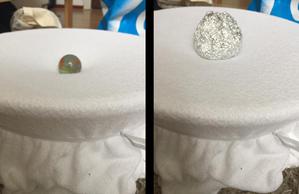Glossary term: Trou noir
Description: Un trou noir est une région de l'espace où la force gravitationnelle est si importante que rien, pas même la lumière, ne peut s'en échapper.
De nombreuses galaxies, dont la Voie Lactée, ont un grand trou noir (connu comme trou noir supermassif) en leur centre.
Les astronomes pensent que les petits trous noirs se forment notamment lorsqu'une étoile massive s'effondre à la fin de sa vie. Cependant, les astronomes ne connaissent pas encore l'origine des trous noirs supermassifs.
La limite extérieure d'un trou noir est appelée horizon des événements.
À proximité des trous noirs, la physique est si extrême que le temps s'écoule beaucoup plus lentement (par rapport à un observateur éloigné du trou noir) et, autour des trous noirs plus petits, les objets sont étirés et déchiquetés. La matière qui tombe vers un trou noir forme un disque d'accrétion. Ce phénomène s'accompagne souvent de jets de matière qui partent de ce disque. Les disques d'accrétion des trous noirs sont la source d'énergie des quasars et autres noyaux actifs de galaxie (AGN), ainsi que de nombreuses autres sources de rayons X.
Related Terms:
See this term in other languages
Term and definition status: The original definition of this term in English have been approved by a research astronomer and a teacher The translation of this term and its definition have been approved by a research astronomer and a teacher
The OAE Multilingual Glossary is a project of the IAU Office of Astronomy for Education (OAE) in collaboration with the IAU Office of Astronomy Outreach (OAO). The terms and definitions were chosen, written and reviewed by a collective effort from the OAE, the OAE Centers and Nodes, the OAE National Astronomy Education Coordinators (NAECs) and other volunteers. You can find a full list of credits here. All glossary terms and their definitions are released under a Creative Commons CC BY-4.0 license and should be credited to "IAU OAE".
If you notice a factual or translation error in this glossary term or definition then please get in touch.
Related Activities
Hunting for black holes
astroEDU educational activity (links to astroEDU website) Description: How do astronomers detect invisible black holes?
License: CC-BY-4.0 Creative Commons Attribution 4.0 International (CC BY 4.0) icons
Tags:
Model
, Experiment
Age Ranges:
12-14
Education Level:
Informal
, Middle School
Areas of Learning:
Modelling
, Observation based
, Problem-solving
, Social Research
Costs:
Low Cost
Duration:
45 mins
Group Size:
Group
Skills:
Constructing explanations
, Developing and using models
What is a black hole?
astroEDU educational activity (links to astroEDU website) Description: What are black holes and what would happen if the Sun was replaced by one of them?
License: CC-BY-4.0 Creative Commons Attribution 4.0 International (CC BY 4.0) icons
Tags:
Model
, Experiment
, Investigation
Age Ranges:
12-14
Education Level:
Informal
, Middle School
Areas of Learning:
Discussion Groups
, Interactive Lecture
, Modelling
, Observation based
, Problem-solving
, Social Research
Costs:
Low Cost
Duration:
45 mins
Group Size:
Group
Skills:
Constructing explanations
, Developing and using models
, Engaging in argument from evidence
, Planning and carrying out investigations
Model of a Black Hole
astroEDU educational activity (links to astroEDU website) Description: Understand the mystery of black holes through a hands-on activity.
License: CC-BY-4.0 Creative Commons Attribution 4.0 International (CC BY 4.0) icons
Tags:
Hands-on
, Model
, Interactive
, Space-time
, Black holes
Age Ranges:
8-10
, 10-12
Education Level:
Primary
, Secondary
Areas of Learning:
Modelling
, Social Research
Costs:
Medium Cost
Duration:
1 hour
Group Size:
Group
Skills:
Asking questions
, Developing and using models











